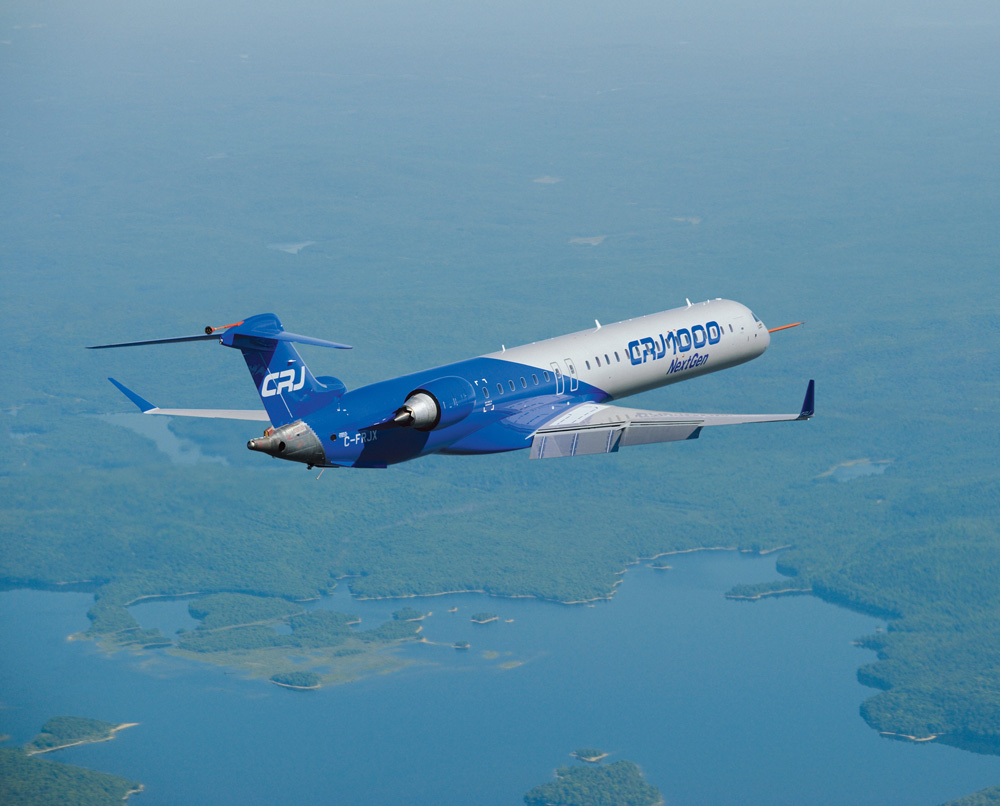Bombardier CRJ700 (Air France)
Role
|
Narrow-body jet airliner
|
National origin
|
Canada
|
Manufacturer
|
Bombardier Aerospace
|
First Flight
|
May 27, 1999
|
Introduction
|
2001
|
Status
|
In production, in service
|
Primary users
|
SkyWest Airlines, Pluna, ExpressJet, Mesaba Airlines
|
Number built
|
602 as of October 2011
|
Unit Cost
|
US$24-39.7 million (2006)
|
Developed from
|
Bombardier CRJ200
|
The Bombardier CRJ700, CRJ900, and CRJ1000 are regional airliners based on the Bombardier CRJ200. Final assembly of the aircraft is at Montréal-Mirabel International Airport in Mirabel, Quebec, outside Montreal, Canada.
CRJ700
Design work on the CRJ700 by Bombardier started in 1995 and the programme was officially launched in January 1997. The CRJ700 is a stretched 70-seat derivative of the CRJ200. Seating ranges from 66 to 78 for the CRJ700 versions, however. The CRJ700 features a new wing with leading edge slats and a stretched and slightly widened fuselage, with a lowered floor.
The aircraft is equipped with two General Electric CF34-8C1 engines. Maximum speed is Mach 0.85 (556 mi/hr, 895 km/hr) at a maximum altitude of 41,000 feet (12,500 m). Depending upon payload, the CRJ700 can travel up to 2,250 miles (3,620 km) with current engines, and a new variant with CF34-8C5 engines will be able to travel up to 2,895 miles (4,660 km).
The CRJ700 comes in three versions: Series 700, Series 701, and Series 702. The 700 is limited to 68 passengers, the 701 to 70 passengers, and the 702 to 78 passengers. The CRJ700 also has three fuel/weight options: standard, ER, and LR. The ER version has an increase in fuel capacity as well as maximum weight, which in turn increases the range. The LR increases those values further. The executive version is marketed as the Challenger 870.
Its first flight took place on May 27, 1999. The aircraft's FAA Type Certificate designation is the CL-600-2C10. The CRJ700 first entered commercial service with Brit Air in 2001.
The CRJ700 directly competes with the Embraer 170, which typically seats 70 passengers.
In 2008, the CRJ700 was replaced with the CRJ700 NextGen, featuring improved economics and a revised cabin common to the CRJ900 NextGen and CRJ1000 NextGen. In January 2011 SkyWest Airlines ordered four CRJ700 NextGen aircraft.
CRJ900
The CRJ900 is a stretched 76-90 seat version of the CRJ700. The aircraft features two GE CF34-8C5 engines, 13,360 lbf (59.4 kN) thrust with APR, and added leading edge slats. Max GTOW is 84,500 pounds. The airplane is loosely based on the CRJ200 series with a few major improvements. The environmental packs have a target temperature instead of a hot-cold knob. The cabin has a recirculation fan which aids in cooling and heating. The engines are controlled by FADEC digital engine control instead of control cables and a fuel control unit. The cabin floor has been lowered 2 inches which gains outward visibility from the windows in the cabin as the windows become closer to eye level height. The APU is a Honeywell RE220 unit which supplies much more air to the AC packs and has higher limits for starting and altitude usage. The wingspan is longer, the tail is redesigned with more span and anhedral. In typical service the CRJ900 can cruise 8-10,000 ft higher with a slightly higher fuel burn and an average true airspeed of 450-500 knots, a significant improvement over its predecessor. The FAA Type Certificate designation of the CRJ900 is the CL-600-2D24.
CRJ1000
On 19 February 2007, Bombardier launched the development of the CRJ1000, previously designated CRJ900X, as a stretched CRJ900, with up to 100 seats. Bombardier claims that it offers better performance and a higher profit per seat than the competing Embraer E-190.Brit Air and Air Nostrum are the launch customers for the CRJ1000. MyAir had ordered 15 CRJ900Xs that were converted to the CRJ1000, but the airline went bankrupt on 24 July 2009. Atlasjet also indicated interest in the new type.
The CRJ1000 successfully completed its first flight in 2008. Bombardier, however, stated that the introduction into service had been delayed until the first quarter of 2010. On 14 June 2009 Bombardier announced a new firm order for 15 CRJ1000 NextGen aircraft placed by Air Nostrum, for a total of 35 CRJ1000 NextGen aircraft. There are 49 firm orders and 4 options for the variant as of August 2009.
The variant completed its first production flight on 28 July 2009 in Montreal; the entry into service was planned then for the first quarter of 2010. A month after the first flight, however, a fault in the rudder controls forced the flight-test program to be grounded. The program was not resumed until February 2010, and deliveries were projected to begin by January 2011.
Bombardier Aerospace announced on 10 November 2010 that its 100-seat CRJ1000 was awarded Aircraft Type Certificates fromTransport Canada and European Aviation Safety Agency, clearing the way for deliveries to begin. On 14 December 2010, Bombardier began CRJ1000 deliveries to Brit Air and Air Nostrum. On 23 December 2010 it was announced that the Federal Aviation Administration had also awarded a type certificate, allowing the CRJ1000 to operate in US airspace. The FAA Type Certificate designation of the CRJ1000 is the CL-600-2E25. In February 2012, Garuda Indonesia airline ordered six CRJ1000s and took options for another 18, and Danish lessor Nordic Aviation Capital ordered 12 for Garuda to operate with delivery beginning in 2012.


